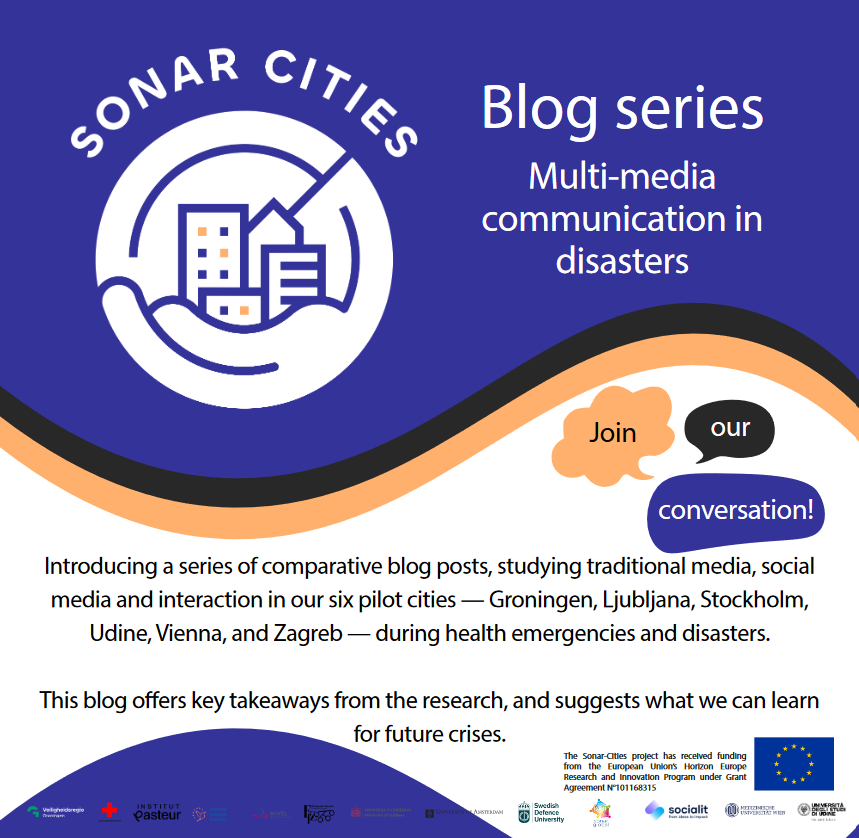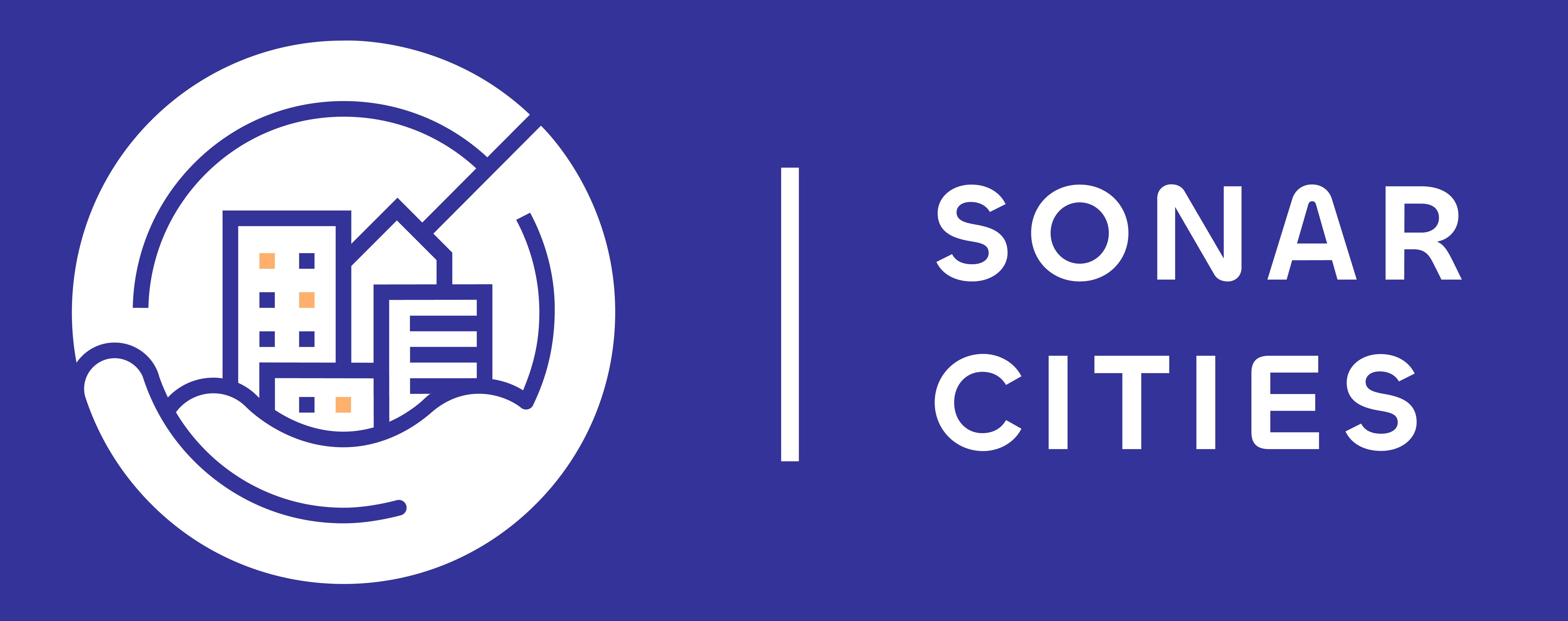Blog post n°1:
What is the public characterization of who is deemed vulnerable during COVID-19? Insights from European Cities:
The COVID-19 pandemic brought renewed attention on how societies perceive vulnerability. What began as a health crisis soon exposed deeper social fractures, revealing who was most at risk—not just from the virus itself, but from the cascading effects of lockdowns, economic strain, and disrupted services. Across six European cities— Groningen, Ljubljana, Stockholm, Udine, Vienna, and Zagreb—media coverage and social media discussions in the first month of the pandemic painted a complex picture of vulnerability, blending medical, economic, cultural, and social factors.
The following blog post presents a comparative overview of the findings of each city team from their studies of social and traditional media coverage.
Traditional Media: Who Made the Headlines?
Most newspaper articles discussed the effects of the pandemic in broad terms, often referring to the general population rather than focusing on specific vulnerable groups. Only a minority explicitly addressed vulnerability or identified particular at-risk categories. The term vulnerable groups as well as vulnerable people were often used vaguely, defaulting to (older) age without deeper exploration. In nearly every city analysed, older adults—particularly those over 75—dominated media narratives. Early findings from Udine framed this population as the most fragile due to high mortality rates in nursing homes. Stockholm’s coverage echoed this, citing Sweden’s Public Health Agency that labelled seniors as a “risk group”. The articles analysed by the Vienna team emphasized the need to protect senior citizens, while Zagreb and Ljubljana highlighted isolation risks. Yet, this focus sometimes overshadowed other vulnerabilities.
People with chronic illnesses (e.g., diabetes, immunosuppression) were frequently cited but less visibly discussed, often lumped with the older adults. Vienna’s media included disabilities but leaned on medicalized language (e.g., “high-risk groups”), not addressing societal barriers like accessibility. In many cases the intersection between age and pre-existing health condition informed who was deemed vulnerable during COVID-19. Regarding age, findings framed children as vulnerable—until school closures. Groningen, Udine, and Zagreb later highlighted their psychological struggles, while Stockholm’s debate centred on schools as transmission hubs.
Healthcare workers were universally recognized as vulnerable—but for distinct reasons. Italian and Croatian media stressed their exposure to infection and emotional toll, while Stockholm’s coverage critiqued systemic failures (e.g., masks shortages). Vienna extended this to care workers and paramedics, acknowledging their burnout. On the other hand, low-income households, unemployed workers, and marginalized groups received uneven attention. Vienna’s media stood out for mentioning homelessness, migrants, and sex workers, while Zagreb’s coverage largely ignored socioeconomic disparities. Ljubljana’s analysed articles tied vulnerability to macroeconomics, framing businesses as “at-risk” alongside people.
Social Media: Grassroots Realities and Gaps
Platforms like Twitter and Facebook revealed struggles absent from traditional media. In general, there are some differences between the accounts we have investigated.
Institutional Accounts: Institutional accounts across cities framed vulnerability using a mix of age, psychological distress, and socioeconomic hardship, though depth and tone varied. In Ljubljana, vulnerability was often intersectional and situated —older adults facing dementia or social isolation, and children from low-income families. Zagreb primarily focused on children’s mental health due to school closures and also highlighted older people and pregnant women. Vienna recognised diverse vulnerabilities, including people with pre-existing conditions, lone individuals, and victims of domestic violence. Udine identified groups such as older adults, low-income families, and people with psychological fragility (e.g. young people, people in isolation, pregnant women), but the communication specifically tailored to their needs was limited. Groningen listed a broad set of vulnerable groups—children, healthcare workers, those with disabilities or literacy challenges—though often with vague definitions. In Stockholm, institutional messaging was minimal, focusing mostly on healthcare workers and psychosocial support for them.
Across the cities, some posts provided access to services like food vouchers or helplines.
Emergency Management Bodies Accounts: Emergency management bodies across the cities tended to define vulnerability more narrowly, often tied to age and health risks, with occasional emphasis on mental well-being. In Ljubljana, older adults, children, pregnant women, and healthcare professionals were acknowledged, with some emotional language used for youth mental health. Zagreb focused on mental health, offering support hotlines and breathing techniques for anxiety, while also portraying healthcare workers as tireless heroes. Vienna highlighted age, social hardship, and psychological stress, and uniquely portrayed young people not only as vulnerable but also as peer supporters. In Stockholm, the main focus was on older adults—especially “70 years and older”—and visually impaired individuals, with translated posts for non-Swedish speakers showing an inclusive intent. Udine mentioned older people and those isolated or in psychological difficulty, but only rarely; healthcare workers were honoured, rather than supported with concrete measures. Groningen referenced children, older adults, those with cognitive challenges, and vaguely defined “people needing help”. A peculiar case was identified in Groningen’s content, where it was noted how specific groups’ low literacy might require specific attention and communicative styles in line with their capabilities. Generally, emergency communications provided guidance more than structural assistance, reinforcing behavioural norms rather than deeply addressing systemic vulnerabilities.
Unlike the posts, the comments joined the solidarity expression but also conveyed scepticism, unmet needs, and critiques, showing no particular differences among analysed accounts. More in detail, Zagreb’s comments highlighted childcare gaps; Ljubljana’s comments demanded accountability from the government; users in Udine criticized unequal mask distribution, highlighting gaps in aid; Stockholm comments debated school policies, with parents fearing for children’s safety. In Groningen there was also notable criticism as some saw the measures as too lenient, while others expressed frustrations and questioned the governments decisions. In Vienna, the discussion focused on safety measures, dog-walking, and kindergarten closures.
Key Takeaways
- Medical Framing Dominated: Age and health conditions defined vulnerability, often sidelining social inequities.
- Grassroots Voices Filled Gaps: Social media highlighted mental health and systemic failures overlooked by officials.
- Inclusivity Remained Patchy: Marginalized groups (e.g., undocumented migrants) were rarely prioritized in policies or messaging.
What Can We Learn for Future Crises?
The pandemic revealed the relevance of situational vulnerability—a form of vulnerability that emerges from specific social, institutional, and environmental contexts—underscoring that vulnerability is not a fixed condition but rather a dynamic state shaped by policies, resource distribution, and structural inequalities. To strengthen resilience, cities should:
- Expand Definitions: Combine medical, economic, cultural (e.g. linguistic) and social factors in risk assessments.
- Listen to Lived Experiences: Use social media to identify emerging vulnerabilities in real time.
- Design Inclusive Communication: Avoid vague terms like “vulnerable groups”; specify ad hoc needs and solutions. Use plain language and clear formats to ensure messages are understandable even for people with limited literacy skills.
This post is part of the SONAR-CITIES project, researching inclusive crisis preparedness in Europe.
Found this insightful? Share it with your network #VulnerabilityInCrises #PublicHealth #Sonarcities
Subscribe for updates on urban resilience research
Follow us for more findings!
Methodological note
COVID-19 data analysis was conducted on material published over a one-month period starting from 11 March 2020, when the WHO declared COVID-19 a pandemic.
The traditional media analysis employed a qualitative thematic approach and considered six newspapers (one per city case study). Newspaper selection was based on three criteria: accessibility of archives, circulation and reach, and relevance to the specific city/study area. The final dataset comprised 1,456 articles, with 30 articles selected per city (one per day) relevant to the “vulnerability” dimension and analysed. An exception was Groningen, where only 21 articles met the relevance criterion and were considered.
For social media, topic modelling was applied. Four social media accounts from different platforms were selected per case study (two institutional and two emergency management bodies), based on: being an official account, accessibility of the data, and relevance to the specific city/study area (1427 posts and 31434 comments). Only publicly available data was scraped through Apify. A more in-depth qualitative analysis focused on Facebook posts (114), deemed the most suitable platform due to its widespread use.

